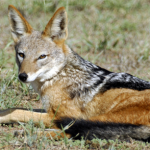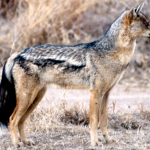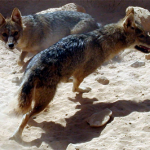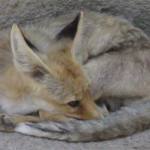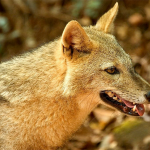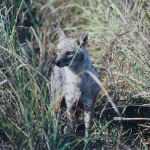Jackals have not had much history at ‘Souls, owing to their natural habitat’s great distance from eastern Canada — Jackal subspecies are found only in Europe, Africa, and Asia. Nonetheless, some jackals have come to ‘Souls in recent years. Jackal packs have not yet been established; however, neither have any packs specifically restricted jackals from joining their ranks.
Note that “jackal” refers to all three common species — the Golden Jackal, the Side-Striped Jackal, and the Black-Backed Jackal are very distinctive species. They are all jackals, but each is a species in its own right, and each has its own subspecies.
Characteristics
Jackals can be compared to small, desert subspecies of coyotes in terms of size and general shape. Their muzzles are far more slender than the Grey Wolf’s, though not as tapered as the coyote’s. Jackals have long legs and slight, lean bodies.
Golden Jackals
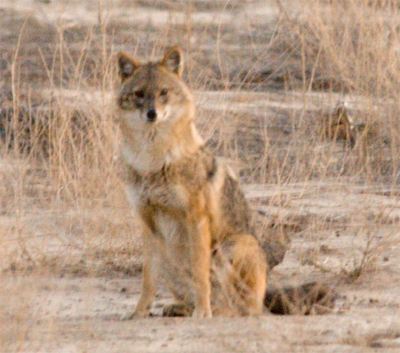
Size
Almost all Jackal species and subspecies are small compared to wolves and coyotes– most Golden Jackals are 15-20 inches (30-50 cm) high at the shoulder and weigh 15-33 pounds (7-15 kg).
Appearance
Golden Jackals are generally–you guessed it–golden in coloration, though some populations in mountainous territory have grey pelts. Some also have a darker back, although this is generally not nearly as pronounced as the one found on its smaller cousin species, the Black-Backed Jackal. Their undersides are lighter in most individuals. Some jackals have been reported to have completely black or piebald coats, though this is a rare phenomenon.
Lifestyle and Culture
Golden Jackals are less social than the Gray Wolf — they typically roam in monogamous male and female pairs throughout a territory region, sometimes with younger individuals from the previous season’s breeding. Golden Jackals experience some fierce competition — wolves and jackals are often at odds for the same types of prey, and they compete intensely with one another where their ranges intersect. Golden Jackals tend to dominate both the Black-Backed and Side-Striped Jackals in competition, though the former is much more aggressive.
Jackals are a highly adaptable species: in North Africa, they live on open desert plains. Although the Golden Jackal is the most desert-capable jackal, they are not found in the deeper reaches of deserts. They are not particularly adapted to cold weather: they cannot traverse through very heavy snowfall without keeping to a path made by another animal first. Temperatures are also a problem, but they are capable of surviving them up to -35 °F (-37 °C).
Side-Striped Jackal
Size
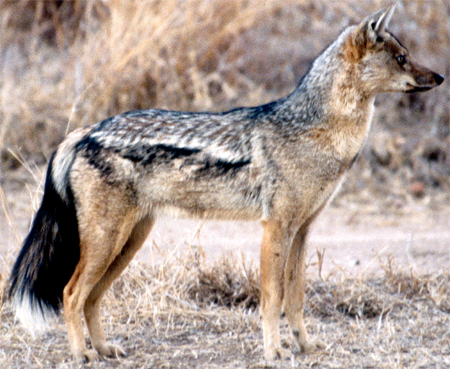
The Side-Striped Jackal are typically 16-20 inches (40-50 cm) tall at the shoulder and weigh 15-26 lbs (7-12 kg). Side-Striped Jackals have a long tail compared to other Canis subspecies, often comprising a full third of their body length.
Appearance
They are typically a grey-brown color, with a darkened back, streaked with some white along its back and always at the tip of its tail. Its ears are typically rounder and slightly smaller than the Black-Backed or Golden Jackal; its teeth and skull shape are more adapted for an omnivorous diet than a strictly carnivorous one. A Side-Striped Jackal’s long, curved canines have a sharp ridge on the posterior surface, and the outer incisors are canine-like.
Lifestyle and Culture
The Side-Striped Jackal is, like most other jackals, less social than its largest cousin, the Wolf. They typically do not form large packs — family groups consist of an alpha breeding pair and a few individuals from the previous season’s litter. They are a territorial species, and their pack structure is rather weak. Although sized similarly, the Side-Striped Jackal is far less aggressive than its cousin, the Black-Backed Jackal.
Side-Striped Jackals tend to prefer densely wooded areas; however, Black-Backed Jackals have displaced Side-Striped Jackals from grassland habitats entirely where their ranges intersect. Subtle influences from Black-Backed Jackals have decreased their range slightly — where there is open savannah and both species, the Black-Backed Jackal invariably wins the territory conflict.
Side-Striped Jackals were not changed by the extinction of humanity; the lack of humans didn’t significantly change them. Luperci traits spread quickly throughout the Side-Striped Jackal populations; in areas where the Side-Striped Jackal is the only canine species (generally the central most parts of their range, as the outskirts of their range intersects with Golden and Black-Backed Jackal ranges), they are among the most sophisticated and humanized of all African canines. They experience little true competition from even very large predators since acquiring the Luperci virus and the ability to wield a weapon.
Black-Backed Jackal
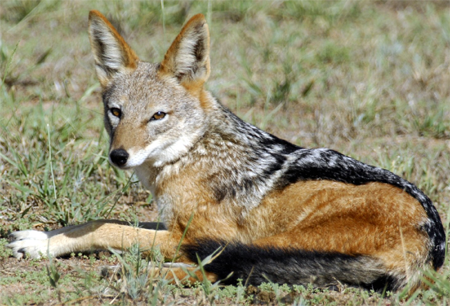
Size
Back-Backed Jackals, or Cape Jackals, stand between 15-19 inches (38-48 cm) at the shoulder and weigh around 15-21 lbs (7-10 kg) for males) and 12-22 lbs (6-10 kg) for females.
Appearance
Their heads are proportionally small and elongated; they are more carnivorous than the Side-Striped Jackal and so they have teeth built for meat-eating. They are typically tawny or yellowish in color, with reddish flanks and legs. The underbellies of Black-Backed Jackals are usually paler in coloration, ranging from creamy to almost white. They have a prominent black saddle — unlike the Side-Striped Jackal, this typically does not contain white. Markings become bolder and more defined as the individual ages; youths under two years of age are unlikely to have clearly defined saddled patterns. Their tails are tipped with black, whereas the Side-Striped Jackal’s tail is tipped white.
Lifestyle and Culture
Black-Backed Jackals are far less social than most other Canis subspecies. Coyotes are social butterflies in comparison to Black-Backed Jackals. Within the species, intrapack relations are often tense and wrought with conflict. These small, aggressive canines are extremely territorial; intruders are not tolerated within the marked boundaries of their territory. Like the Wolf, territories are held by an alpha male and female, the only pair to breed. Other canines allowed in the territory are typically grown children from the previous mating season; however, the mother jackal more typically drives the children off when they are between six and eight months.
Following the destruction of humanity, Black-Backed Jackals suffered somewhat — many had adapted to living in agricultural areas in Africa, and of course, as humanity died, so did large portions of imported livestock. Jackals had to reconvert to their earlier survival tactics and competed with Golden Jackals and Ethiopian Wolves in northern parts of their range; this depression in population was brief, and the jackal numbers in southern Africa re-stabilized rather quickly. Many jackals have begun re-adapting to abandoned human spaces; while southern Africa is not yet as humanized as areas of Europe, lifestyles modeled after humanity are not altogether uncommon.
Hybridization
Golden Jackals (and all subspecies) are more closely related to the Gray Wolf and the Coyote than other Jackal species and subspecies. Golden Jackals more easily hybridize with wolves, dogs, and other members of the Canis genus. Golden Jackals also have 78 chromosomes like the Gray Wolf and Coyote.
The Black-Backed and Side-Striped Jackals both have 74 chromosomes, as they diverged far earlier than Golden Jackals. Offspring of these canines and other Canis subspecies with 78 chromosomes may be infertile or more prone to genetic disorders.
Subspecies
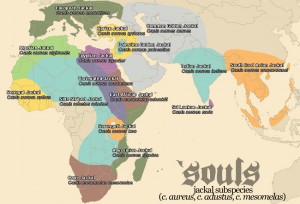
- C. a. aureus: Common Golden Jackal (nominative subspecies)
- C. a. algirensis: Algerian Jackal
- C. a. anthus: Senegal Jackal
- C. a. bea: Serengeti Jackal
- C. a. cruesemanni: Siamese Jackal
- C. a. indicus: Indian Jackal
- C. a. lupaster: Egyptian Jackal
- C. a. moreoticus: European Jackal
- C. a. naria: Sri Lanka Jackal
- C. a. riparius: Abyssinian Jackal
- C. a. soudanicus: Variegated Jackal
- C. a. syriacus: Syrian Jackal
- C. a. palaestina: Palestine Golden Jackal
- Other Jackals:
- C. m. mesomelas: Cape Jackal
- C. m. schmidti: East African Cape Jackal
- C. a. adustus: Side-Striped Jackal
